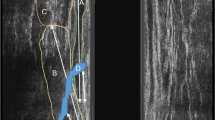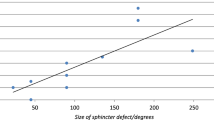Abstract
Fifty-six patients with high anorectal anomalies treated by anorectoplasty at the Royal Children's Hospital, Melbourne were assessed clinically after 5–32 years. Each patient was graded by the Kelly, Templeton, Kiesewetter, and Wingspread continence scoring methods. Grades of continence assessed by each method had substantial or excellent concordance, although the Templeton “faecal continence score” assigned a higher grade of anorectal continence than the other three. The Wingspread system was useful for monitoring the current status of the individual patient and continued dependence on therapy, but its complex and descriptive nature made it difficult to use in comparisons between series. The Kelly scoring method involves digital examination of the rectum but is simple to apply, and gave as good an indication of the functional level of anorectal continence as the other schemes.
Similar content being viewed by others
References
Cywes S, Cremin BJ, Louw JH (1971) Assessment of continence after treatment for anorectal agenesis: a clinical and radiologic correlation. J Pediatr Surg 6: 132–137
de Vries PA (1988) Results of treatment and their assessment. In: Stephens FD, Smith ED, Paul NW (eds) Anorectal malformations in children: update 1988. Liss, New York, pp 481–500
Ditesheim JA, Templeton JM Jr (1987) Short-term vs long-term quality of life in children following repair of high imperforate anus. J Pediatr Surg 22: 581–587
Iwai N, Ogita S, Kida M, Fujita Y, Susumu M (1979) A clinical and manometric correlation for assessment of postoperative continence in imperforate anus. J Pediatr Surg 14: 538–543
Iwai N, Yanagihara J, Tokiwa K, Deguchi E, Takahashi T (1988) Voluntary anal continence after surgery for anorectal malformations. J Pediatr Surg 23: 393–397
Kelly JH (1972) The clinical and radiological assessment of anal continence in childhood. Aust NZ J Surg 42: 62–63
Kiesewetter WB, Chang JHT (1977) Imperforate anus: a five to thirty year follow-up perspective. Prog Pediatr Surg 10: 111–120
Ong NT, Beasley SW (1990) Longterm continence in patients with high anorectal anomalies treated by sacroperineal [Stephens] rectoplasty. J Pediatr Surg (in press)
Smith ED (1987) The bath water needs changing, but don't throw out the baby: an overview of anorectal anomalies. J Pediatr Surg 22: 335–348
Smith EI, Tunell WP, Williams GR (1978) A clinical evaluation of the surgical treatment of anorectal malformations (imperforate anus). Ann Surg 187: 583–592
Stephens FD, Smith ED (1971) Ano-rectal malformations in children. Year Book Medical Publishers, Chicago
Stephens FD, Smith ED (1986) Classification, identification, and assessment of surgical treatment of anorectal anomalies. Pediatr Surg Int 1: 200–205
Templeton JM Jr, Ditesheim JA (1985) High imperforate anus —quantitative results of long-term fecal continence. J Pediatr Surg 20: 645–652
Author information
Authors and Affiliations
Additional information
Offprint requests to: S. W. Beasley
Rights and permissions
About this article
Cite this article
Ong, NT., Beasley, S.W. Comparison of clinical methods for the assessment of continence after repair of high anorectal anomalies. Pediatr Surg Int 5, 233–237 (1990). https://doi.org/10.1007/BF00169659
Issue Date:
DOI: https://doi.org/10.1007/BF00169659




